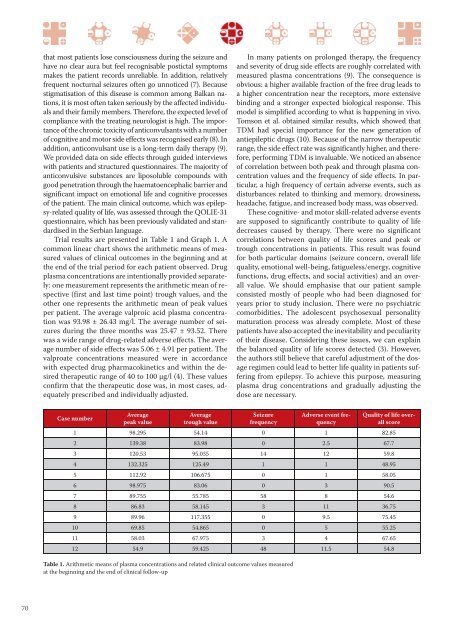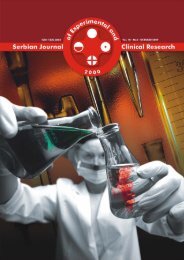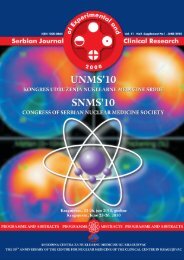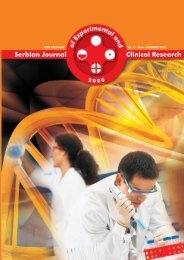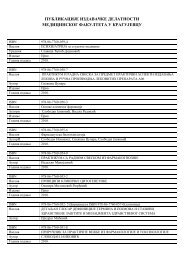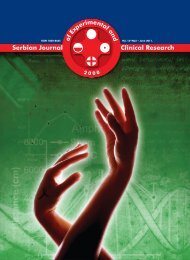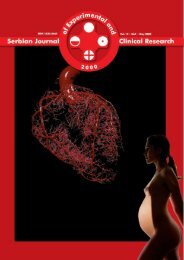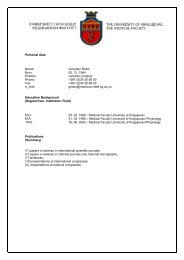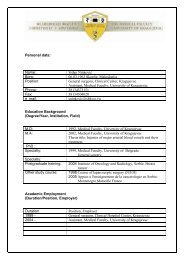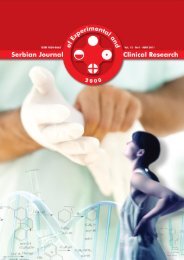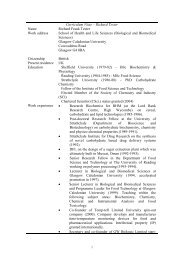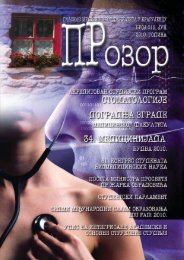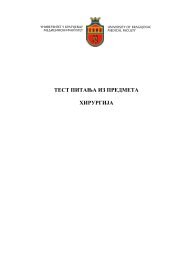Untitled - Medicinski fakultet Kragujevac - Univerzitet u Kragujevcu
Untitled - Medicinski fakultet Kragujevac - Univerzitet u Kragujevcu
Untitled - Medicinski fakultet Kragujevac - Univerzitet u Kragujevcu
Create successful ePaper yourself
Turn your PDF publications into a flip-book with our unique Google optimized e-Paper software.
70<br />
that most patients lose consciousness during the seizure and<br />
have no clear aura but feel recognisable postictal symptoms<br />
makes the patient records unreliable. In addition, relatively<br />
frequent nocturnal seizures often go unnoticed (7). Because<br />
stigmatisation of this disease is common among Balkan nations,<br />
it is most often taken seriously by the affected individuals<br />
and their family members. Therefore, the expected level of<br />
compliance with the treating neurologist is high. The importance<br />
of the chronic toxicity of anticonvulsants with a number<br />
of cognitive and motor side effects was recognised early (8). In<br />
addition, anticonvulsant use is a long-term daily therapy (9).<br />
We provided data on side effects through guided interviews<br />
with patients and structured questionnaires. The majority of<br />
anticonvulsive substances are liposoluble compounds with<br />
good penetration through the haematoencephalic barrier and<br />
significant impact on emotional life and cognitive processes<br />
of the patient. The main clinical outcome, which was epilepsy-related<br />
quality of life, was assessed through the QOLIE-31<br />
questionnaire, which has been previously validated and standardised<br />
in the Serbian language.<br />
Trial results are presented in Table 1 and Graph 1. A<br />
common linear chart shows the arithmetic means of measured<br />
values of clinical outcomes in the beginning and at<br />
the end of the trial period for each patient observed. Drug<br />
plasma concentrations are intentionally provided separately:<br />
one measurement represents the arithmetic mean of respective<br />
(first and last time point) trough values, and the<br />
other one represents the arithmetic mean of peak values<br />
per patient. The average valproic acid plasma concentration<br />
was 93.98 ± 26.43 mg/l. The average number of seizures<br />
during the three months was 25.47 ± 93.52. There<br />
was a wide range of drug-related adverse effects. The average<br />
number of side effects was 5.06 ± 4.91 per patient. The<br />
valproate concentrations measured were in accordance<br />
with expected drug pharmacokinetics and within the desired<br />
therapeutic range of 40 to 100 μg/l (4). These values<br />
confirm that the therapeutic dose was, in most cases, adequately<br />
prescribed and individually adjusted.<br />
Case number<br />
Average<br />
peak value<br />
Average<br />
trough value<br />
In many patients on prolonged therapy, the frequency<br />
and severity of drug side effects are roughly correlated with<br />
measured plasma concentrations (9). The consequence is<br />
obvious: a higher available fraction of the free drug leads to<br />
a higher concentration near the receptors, more extensive<br />
binding and a stronger expected biological response. This<br />
model is simplified according to what is happening in vivo.<br />
Tomson et al. obtained similar results, which showed that<br />
TDM had special importance for the new generation of<br />
antiepileptic drugs (10). Because of the narrow therapeutic<br />
range, the side effect rate was significantly higher, and therefore,<br />
performing TDM is invaluable. We noticed an absence<br />
of correlation between both peak and through plasma concentration<br />
values and the frequency of side effects. In particular,<br />
a high frequency of certain adverse events, such as<br />
disturbances related to thinking and memory, drowsiness,<br />
headache, fatigue, and increased body mass, was observed.<br />
These cognitive- and motor skill-related adverse events<br />
are supposed to significantly contribute to quality of life<br />
decreases caused by therapy. There were no significant<br />
correlations between quality of life scores and peak or<br />
trough concentrations in patients. This result was found<br />
for both particular domains (seizure concern, overall life<br />
quality, emotional well-being, fatigueless/energy, cognitive<br />
functions, drug effects, and social activities) and an overall<br />
value. We should emphasise that our patient sample<br />
consisted mostly of people who had been diagnosed for<br />
years prior to study inclusion. There were no psychiatric<br />
comorbidities. The adolescent psychosexual personality<br />
maturation process was already complete. Most of these<br />
patients have also accepted the inevitability and peculiarity<br />
of their disease. Considering these issues, we can explain<br />
the balanced quality of life scores detected (3). However,<br />
the authors still believe that careful adjustment of the dosage<br />
regimen could lead to better life quality in patients suffering<br />
from epilepsy. To achieve this purpose, measuring<br />
plasma drug concentrations and gradually adjusting the<br />
dose are necessary.<br />
Seizure<br />
frequency<br />
Adverse event frequency<br />
Quality of life overall<br />
score<br />
1 98.295 54.14 0 1 82.85<br />
2 139.38 83.98 0 2.5 67.7<br />
3 120.53 95.035 14 12 59.8<br />
4 132.325 125.49 1 1 48.95<br />
5 112.92 106.675 0 1 58.05<br />
6 98.975 83.06 0 3 90.5<br />
7 89.755 55.785 58 8 54.6<br />
8 86.83 58.145 3 11 36.75<br />
9 89.96 117.355 0 9.5 75.45<br />
10 69.85 54.865 0 5 55.25<br />
11 58.03 67.975 3 4 67.65<br />
12 54.9 59.425 48 11.5 54.8<br />
Table 1. Arithmetic means of plasma concentrations and related clinical outcome values measured<br />
at the beginning and the end of clinical follow-up


